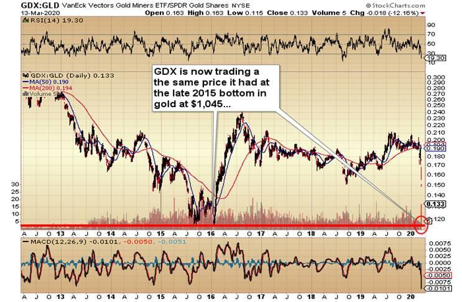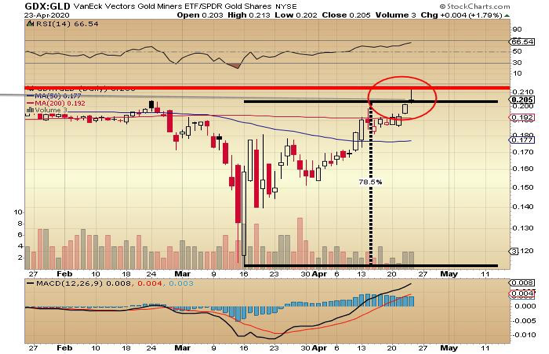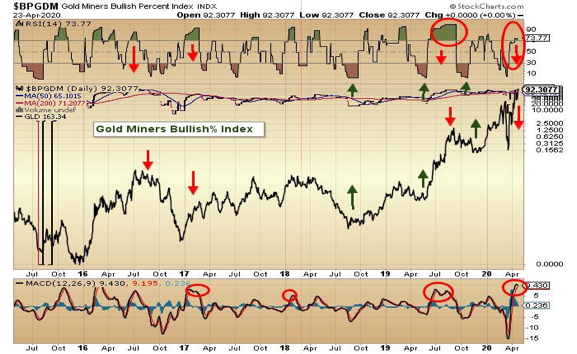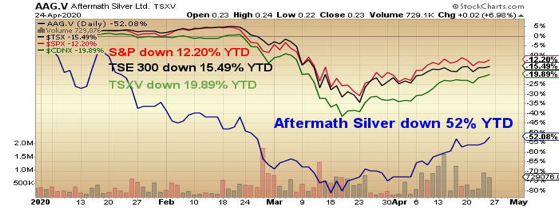Before I get started on my weekly commentary, I want to thank you all for the waterfall of responses to A Boomer's Plea posted last weekend, in what I must confess was my most impassioned missive of a multi-decade writing career. Speaking out as a member of the generation I chose to assail was an absolute joy, and I must tell you that the responses were almost unanimously similar across all age brackets. What surprised me was that the Millennials who read the article thanked me for writing it because finally they had some ammunition to put in front of their Grampa (as they argued for "free everything"). Even my 92-year-old (English) mother-in-law loved it, but said that I was "being too 'ard on yaself." Anyway, I thank you all.
I think that March 16, 2020, and April 21, 2020, will be remembered as two dates in history that redefined the definition of "buy the panic," because not only did investors have to cope with all of the headlines depicting doom and gloom, they were also up against all those supercomputers running algorithmic software designed to trade faster than all of us. Ironically, the algos could not cope with "irrational panic" and instead simply "followed instructions" laid down by the "code writers" and proceeded to sell May oil futures down to negative US$40 per barrel. I am going to repeat that: minus $40 per barrel.
. . .Pregnant pause allowing data to sink in. . .
I am usually not excessively demonstrative in speaking about oil, but it is close to my sexagenarian heart because I entered the securities industry in 1977 as a trainee in the midst of the biggest oil boom in Canadian history, centered in the West Pembina fields of Alberta. I watched all the salespeople scrambling around from desk to desk, desperateto get the latest scoop on the drilling results from Oakwood Pete or Ascot Pete or "the mighty Sundance." I watched a salesman (as opposed to "wealth manager") one morning take fifty orders to buy the entire issued capital of a junior oil explorer called Liberty Petroleum, after which he had a total meltdown because his compliance department said it was "too risky." The orders were from the family members of a Saudi prince. The broker resigned the following day.
A good friend called me tonight to report that his private exploration deal over in the Middle East just made an absolutely humongous oil discovery above 465 feet depth that tested an economic 8,000 bpd (barrels per day), at which I a) spit out my coffee, and b) coughed loudly, and c) nearly soiled my garments. Let me give you some mathematics on an 8,000-bpd oil discovery: At the low trade on Tuesday for June crude oil futures, at US$6.50 per barrel, it is US$1.56 million per month. At tonight's closing price of US$16.75 for June crude oil futures, it is US$4.02 million per month. Oil discoveries of that magnitude are generational wealth creators, and it is why the Middle East remains such a strategic region for the world powers.
I must explain something to you all. Wall Street hates gold but it loves oil. Wall Street does not understand gold, but it does understand and appreciate oil. Timed properly, investors can make a great deal of money in the oil sector and in the 1970s, it was gold and oil that dominated portfolios. Drilling in the Beaufort Sea with Dome Petroleum, Gulf Canada and Mobil captivated speculators for years, until the mighty Hibernia discovery offshore Newfoundland emerged as the new hotbed.
I mention this because the recent crash in oil represents an opportunity for serious capital gains once the world solves the economic shutdown issues and, coupled with gold, portfolios holding oil are perfectly hedged against the currency debasement actions occurring everywhere a central bank exists.
Moving to the gold miners, here is a chart from March 13, when I sent out my "Generational Buy" recommendation on the Senior Gold Miners as measured in terms of the gold ETF (GLD:US).

On the morning of March 16, 2020, the ratio of GDX (the Senior Miner exchange-traded fund [ETF]) to GLD (the physical gold ETF that tracks spot gold prices) had fallen all the way down to December 2015 levels, when gold reached its four-year nadir at $1,045 per ounce. I told subscribers that I was going to buy GDX on the Monday opening and I did, with three separate call option purchases for August expiry. Having now taken profits, those three purchases have made my year, because within the next five weeks, GDX has bolted from the 52-week low of US$16.18 that very morning to a six-year high of US$34.74 earlier this week. A double in five weeks!
So, with the precious metals stocks now the talk of the town and every wealth manager and his fuzzy-cheeked assistant scrambling for positioning in a sector they absolutely hate but must now own (because every other wealth manager in the office does), the space that was underloved and underowned three weeks ago is now hotter than Hades in July.
The same chart of the GDX-GLD ratio that screamed "Generational Buying Opportunity" in mid-March is shown below.

The ratio has advanced from 0.133 to 0.205, and is up 78.5% in the last five weeks, so naturally, with such huge gains staring me in the kisser, is it not prudent to pull in one's horns and bunker some profits? Well, let me dig deeper and look at the Bullish Percent Index (BPI) for the gold miners. Since the lows in 2015, every time the BPI for the gold miners moves above 90, especially when coupled with a Daily Sentiment Index also above 90 (which it is), there has been a bout of profit-taking. If you recall last September, when I issued my sell signal for the precious metals (PMs), we had conditions like those of today.
Now, this does not mean I have turned bearish and am about to sell my entire physical stash or dump everything in the portfolio. What the charts are telling me is—quite simply—that caution is warranted. No new buying.

On April 21, the day that May crude crashed to minus US$40/barrel, I issued an email alert recommending three of the crude oil ETFs and then proceeded to add the following day. I opted for two unleveraged ETFs and one high-risk double-leveraged issue that is extremely volatile but down from over US$500 to under $20 since New Year's Day. That is tantamount to buying the double leveraged junior miner ETF (JUNG:US) on March 19, at $35, down from over $1,000 in February.
The term "regression to the mean" is what always happens after a five-ten sigma event in any market, which is what we just went through. I see that happening in crude oil over the course of the next several weeks and since oil has not yet experienced any kind of meaningful recovery rally, the oil space is lower risk than gold at this time. Subscribers now have the list of oil issues I like and have acted accordingly.

Last point of discussion for this week concerns the junior explorers and developers that I continue to hold and accumulate. I am also actively seeking out properties and projects where there exists either a gold or silver resource previously deemed either marginal or sub-economic, but unlike one year ago, when they were plentiful, most of the decent ones have been snapped up. The projects still largely orphaned by the investment community are the exploration deals, as this new generation of investors is leery of the risks associated with mineral exploration.
It is on this last point that I think the mood will be soon changing. Prior to 1973, oil exploration was nowhere near the investing radar screens, but with the oil embargo and wars and inflation, once oil prices began their decade-long, parabolic ascent to over $40/barrel, the juniors came alive with a vengeance and stayed in the limelight for most of the 1970s.
With gold about to break out to all-time highs sometime in 2020, the upside leverage will not be in the blue-chip senior or intermediate producers, but in the "penny dreadfuls" that become "dollar darlings" after a discovery is made. Right now, we are seeing a sharp increase in interest for those developer/explorers that have either a historical or an NI-43-101-compliant resource in excess of 1 million ounces of gold or 100 million ounces of silver, with gold attracting many more eyeballs than silver.
Most of these micro-cap issues trade on either the U.S. OTC market or the two Canadian junior markets, the TSX Venture Exchange or the Canadian Securities Exchange. I prefer the TSX.V for a number of reasons, but mainly because it has recently begun to trade sufficient volumes to support institutional participation. If the "penny dreadfuls" are to start blossoming into "dollar darlings," it is the migration of the Millennials to the TSX.V that is jump-starting this metamorphosis.
In the COVID-19 March meltdown, the TSX.V was obliterated. exactly as happened in '87, '97 and 2008. In fact, it traded at the lowest level in its history since being merged with the old Vancouver and Alberta Stock Exchanges in the late '90s! At the current 456 level, it is still beneath the January 2016 low at 466, when the HUI traded under 100 and gold was in the $1,050 range.
Now, in recent years, the bosses at the TSX.V decided to "diversify" away from resource exploration and development deals and proceeded to invite start-up technology issues (including crypto), and then cannabis to the party, leaving the door of risk wide open when the last two Millennial-driven manias blew up. First crypto, then weed, went crashing back to earth, taking the index and an entire generation of young investors with them.
The recent meltdown would not have been as devastating had the TSX.V been as gold-centric as it had been in 2008 or 2016. Nevertheless, at 456, the TSX.V is coming hard off the canvas largely due to the precious metal issuers, and for this reason I believe that it has the capability of doubling in 2020, and doubling again in 2021. With the global money conjurers running overtime and with every panic button on earth being multi-pressed, those junior gold and silver explorer/developers trading under a quarter are going to be dragged higher by the rise in the gold price. To wit, when the global China-driven commodity boom was in full bloom in 2007, the TSX.V was trading north of 3,350, or 7.3 times its current level.


For these reasons, I have elected to overweight my portfolio with select junior developer/explorers such as Getchell Gold Corp. (GTCH:CSE), which remains up 75% year to date. This company remains infinitely attractive due to its 1,069,000 ounces of gold in the Fondaway Canyon asset in Nevada, and all kinds of blue-sky potential through its sensitivity to the gold price, substantial exploration potential, and the likelihood of rerating.

Another issue I currently hold, after first identifying it as an above average purchase candidate last summer, is Chilean silver developer Aftermath Silver Ltd. (AAG:TSX.V). While it is currently up over 120% from my initial entry in 2019, it ended last year as my best performer, up 500% since my first tweet at CA$0.10 in early July. With silver prices in the performance doghouse so far in 2020, Aftermath is the ideal silver deal if one still believes the "poor man's gold" can recover from what has been a dismal showing.
I am building a larger list of juniors that I believe will have 10- or 20-bagger potential, and I see this subsector as "the place to be" as this multi-year bull market in gold unfolds. As more and more generalist money managers join the precious metals lovefest, an absolute tsunami of capital will be chasing the gold miners as they scramble up the ladder of risk, creating a trickle-down effect into the developer/explorer names. Therein lies the key to supersized returns for the balance of 2020.
Positioning early is going to be critical so fasten those seatbelts and keep all appendages inside the vehicle before the ride begins.
Originally trained during the inflationary 1970s, Michael Ballanger is a graduate of Saint Louis University where he earned a Bachelor of Science in finance and a Bachelor of Art in marketing before completing post-graduate work at the Wharton School of Finance. With more than 30 years of experience as a junior mining and exploration specialist, as well as a solid background in corporate finance, Ballanger's adherence to the concept of "Hard Assets" allows him to focus the practice on selecting opportunities in the global resource sector with emphasis on the precious metals exploration and development sector. Ballanger takes great pleasure in visiting mineral properties around the globe in the never-ending hunt for early-stage opportunities.
[NLINSERT]Disclosure:
1) Michael J. Ballanger: I, or members of my immediate household or family, own securities of the following companies mentioned in this article: Aftermath Silver and Getchell Gold. My company has a financial relationship with the following companies referred to in this article: Aftermath Silver and Getchell Gold. I determined which companies would be included in this article based on my research and understanding of the sector. Additional disclosures are below.
2) The following companies mentioned in this article are billboard sponsors of Streetwise Reports: None. Click here for important disclosures about sponsor fees. As of the date of this article, an affiliate of Streetwise Reports has a consulting relationship with Aftermath Silver. Please click here for more information. Within the last six months, an affiliate of Streetwise Reports has disseminated information about the private placement of the following companies mentioned in this article: Aftermath.
3) Statements and opinions expressed are the opinions of the author and not of Streetwise Reports or its officers. The author is wholly responsible for the validity of the statements. The author was not paid by Streetwise Reports for this article. Streetwise Reports was not paid by the author to publish or syndicate this article. Streetwise Reports requires contributing authors to disclose any shareholdings in, or economic relationships with, companies that they write about. Streetwise Reports relies upon the authors to accurately provide this information and Streetwise Reports has no means of verifying its accuracy.
4) This article does not constitute investment advice. Each reader is encouraged to consult with his or her individual financial professional and any action a reader takes as a result of information presented here is his or her own responsibility. By opening this page, each reader accepts and agrees to Streetwise Reports' terms of use and full legal disclaimer. This article is not a solicitation for investment. Streetwise Reports does not render general or specific investment advice and the information on Streetwise Reports should not be considered a recommendation to buy or sell any security. Streetwise Reports does not endorse or recommend the business, products, services or securities of any company mentioned on Streetwise Reports.
5) From time to time, Streetwise Reports LLC and its directors, officers, employees or members of their families, as well as persons interviewed for articles and interviews on the site, may have a long or short position in securities mentioned. Directors, officers, employees or members of their immediate families are prohibited from making purchases and/or sales of those securities in the open market or otherwise from the time of the interview or the decision to write an article until three business days after the publication of the interview or article. The foregoing prohibition does not apply to articles that in substance only restate previously published company releases. As of the date of this article, officers and/or employees of Streetwise Reports LLC (including members of their household) own securities of Aftermath Silver and Getchell Gold, companies mentioned in this article.
Charts provided by the author.
Michael Ballanger Disclaimer:
This letter makes no guarantee or warranty on the accuracy or completeness of the data provided. Nothing contained herein is intended or shall be deemed to be investment advice, implied or otherwise. This letter represents my views and replicates trades that I am making but nothing more than that. Always consult your registered advisor to assist you with your investments. I accept no liability for any loss arising from the use of the data contained on this letter. Options and junior mining stocks contain a high level of risk that may result in the loss of part or all invested capital and therefore are suitable for experienced and professional investors and traders only. One should be familiar with the risks involved in junior mining and options trading and we recommend consulting a financial adviser if you feel you do not understand the risks involved.





























































